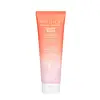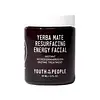What's inside
What's inside
 Key Ingredients
Key Ingredients

 Benefits
Benefits

 Concerns
Concerns

 Ingredients Side-by-side
Ingredients Side-by-side

Water
Skin ConditioningAloe Barbadensis Leaf Juice
Skin ConditioningCaprylic/Capric Triglyceride
MaskingGlycerin
HumectantGlyceryl Stearate
EmollientCetyl Alcohol
EmollientStearyl Alcohol
EmollientSodium Cocoyl Isethionate
CleansingHelianthus Annuus Seed Oil
EmollientHydroxypropyl Starch Phosphate
Hydrolyzed Jojoba Esters
Skin ConditioningPerlite
AbsorbentOryza Sativa Starch
AbsorbentParfum
MaskingEthylhexylglycerin
Skin ConditioningTerminalia Ferdinandiana Fruit Extract
AntioxidantAscorbic Acid
AntioxidantLactic Acid
BufferingGlycolic Acid
BufferingPapain
Skin ConditioningBromelain
Skin ConditioningMaltodextrin
AbsorbentTocopherol
AntioxidantMalic Acid
BufferingVanilla Planifolia Fruit Extract
Skin ConditioningPhenoxyethanol
PreservativeIron Oxides
Galactoarabinan
Sodium Riboflavin Phosphate
Skin ConditioningWater, Aloe Barbadensis Leaf Juice, Caprylic/Capric Triglyceride, Glycerin, Glyceryl Stearate, Cetyl Alcohol, Stearyl Alcohol, Sodium Cocoyl Isethionate, Helianthus Annuus Seed Oil, Hydroxypropyl Starch Phosphate, Hydrolyzed Jojoba Esters, Perlite, Oryza Sativa Starch, Parfum, Ethylhexylglycerin, Terminalia Ferdinandiana Fruit Extract, Ascorbic Acid, Lactic Acid, Glycolic Acid, Papain, Bromelain, Maltodextrin, Tocopherol, Malic Acid, Vanilla Planifolia Fruit Extract, Phenoxyethanol, Iron Oxides, Galactoarabinan, Sodium Riboflavin Phosphate
Water
Skin ConditioningBambusa Arundinacea Stem Extract
Skin ConditioningDiatomaceous Earth
AbrasiveCarthamus Tinctorius Seed Oil
MaskingPropanediol
SolventAloe Barbadensis Leaf Juice
Skin ConditioningCetyl Alcohol
EmollientGlyceryl Stearate
EmollientGlycerin
HumectantLactic Acid
BufferingSodium Acrylate/Sodium Acryloyldimethyl Taurate Copolymer
Emulsion StabilisingNiacinamide
SmoothingPhenoxyethanol
PreservativeC15-19 Alkane
SolventIlex Paraguariensis Leaf Extract
PerfumingIlex Guayusa Leaf Extract
Skin ProtectingPotassium Sorbate
PreservativePolyglyceryl-6 Laurate
EmulsifyingTocopherol
AntioxidantEthylhexylglycerin
Skin ConditioningBromelain
Skin ConditioningSodium Phytate
Papain
Skin ConditioningPolyglycerin-6
HumectantZingiber Officinale Root Oil
MaskingPassiflora Edulis Fruit Extract
Skin ConditioningXanthan Gum
EmulsifyingCurcuma Longa Root Powder
Skin ConditioningHylocereus Undatus Fruit Extract
Skin ConditioningWater, Bambusa Arundinacea Stem Extract, Diatomaceous Earth, Carthamus Tinctorius Seed Oil, Propanediol, Aloe Barbadensis Leaf Juice, Cetyl Alcohol, Glyceryl Stearate, Glycerin, Lactic Acid, Sodium Acrylate/Sodium Acryloyldimethyl Taurate Copolymer, Niacinamide, Phenoxyethanol, C15-19 Alkane, Ilex Paraguariensis Leaf Extract, Ilex Guayusa Leaf Extract, Potassium Sorbate, Polyglyceryl-6 Laurate, Tocopherol, Ethylhexylglycerin, Bromelain, Sodium Phytate, Papain, Polyglycerin-6, Zingiber Officinale Root Oil, Passiflora Edulis Fruit Extract, Xanthan Gum, Curcuma Longa Root Powder, Hylocereus Undatus Fruit Extract
 Reviews
Reviews

Ingredients Explained
These ingredients are found in both products.
Ingredients higher up in an ingredient list are typically present in a larger amount.
Aloe Barbadensis Leaf Juice comes from leaves of the aloe plant. Aloe Barbadensis Leaf Juice is best known for helping to soothe sunburns. It is also anti-inflammatory, moisturizing, antiseptic, and can help heal wounds.
Aloe is packed with good stuff including Vitamins A, C, and E. These vitamins are antioxidants, which help fight free-radicals and the damage they may cause. Free-radicals are molecules that may damage your skin cells, such as pollution.
Aloe Barbadensis Leaf Juice also contains sugars. These sugars come in the form of monosaccharides and polysaccharides, folic acid, and choline. These sugars are able to help bind moisture to skin.
It also contains minerals such as calcium, 12 anthraquinones, fatty acids, amino acids, and Vitamin B12.
Learn more about Aloe Barbadensis Leaf JuiceWe don't have a description for Bromelain yet.
Cetyl Alcohol is a fatty alcohol. Fatty Alcohols are most often used as an emollient or to thicken a product.
Its main roles are:
Though it has "alcohol" in the name, it is not related to denatured alcohol or ethyl alcohol.
The FDA allows products labeled "alcohol-free" to have fatty alcohols.
Learn more about Cetyl AlcoholEthylhexylglycerin (we can't pronounce this either) is commonly used as a preservative and skin softener. It is derived from glyceryl.
You might see Ethylhexylglycerin often paired with other preservatives such as phenoxyethanol. Ethylhexylglycerin has been found to increase the effectiveness of these other preservatives.
Glycerin is already naturally found in your skin. It helps moisturize and protect your skin.
A study from 2016 found glycerin to be more effective as a humectant than AHAs and hyaluronic acid.
As a humectant, it helps the skin stay hydrated by pulling moisture to your skin. The low molecular weight of glycerin allows it to pull moisture into the deeper layers of your skin.
Hydrated skin improves your skin barrier; Your skin barrier helps protect against irritants and bacteria.
Glycerin has also been found to have antimicrobial and antiviral properties. Due to these properties, glycerin is often used in wound and burn treatments.
In cosmetics, glycerin is usually derived from plants such as soybean or palm. However, it can also be sourced from animals, such as tallow or animal fat.
This ingredient is organic, colorless, odorless, and non-toxic.
Glycerin is the name for this ingredient in American English. British English uses Glycerol/Glycerine.
Learn more about GlycerinGlyceryl Stearate is a mix of glycerin and stearic acid.
It is used to stabilize the mixing of water and oil ingredients. By preventing these ingredients from separating, it can help elongate shelf life. It can also help thicken the product's texture.
As an emollient, it helps soften skin and supports barrier-replenishing ingredients.
In cosmetics, Glyceryl Stearate is often made from vegetable oils or synthetically produced.
This ingredient may not be fungal-acne safe
Fun fact: The human body also creates Glyceryl Stearate naturally.
Learn more about Glyceryl StearateLactic Acid is another well-loved alpha hydroxy acid (AHA). It is gentler than glycolic acid but still highly effective.
Its main role is to exfoliate the surface of the skin by loosening the “glue” that holds dead skin cells together. Shedding those old cells leads to smoother, softer, and more even-toned skin.
Because lactic acid molecules are larger than glycolic acid, they don’t penetrate as deeply. This means they’re less likely to sting or irritate, making it a great choice for beginners or those with sensitive skin.
Like glycolic acid, it can:
Lactic acid also acts as a humectant (like hyaluronic acid). It can draw water into the skin to improve hydration and also plays a role in the skin's natural moisturizing factor (NMF) in the form of sodium lactate.
Studies show it can boost ceramide production to strengthen the skin barrier and even help balance the skin’s microbiome.
To get results, choose products with a pH between 3-4.
Lower strengths (5-12%) focus on surface exfoliation; higher strengths (12% and up) can reach deeper in the dermis (deeper, supportive layer) to improve skin texture and firmness over time.
Though it was originally derived from milk, most modern lactic acid used in skincare is vegan. It is made through non-dairy fermentation to create a bio-identical and stable form suitable for all formulations.
When lactic acid shows up near the end of an ingredient list, it usually means the brand added just a tiny amount to adjust the product’s pH.
Legend has it that Cleopatra used to bathe in sour milk to help reduce wrinkles.
Lactic acid is truly a gentle multitasker: it exfoliates, hydrates, strengthens, and brightens. It's a great ingredient for giving your skin a smooth, glowing, and healthy look without the harshness of stronger acids.
Read more about some other popular AHA's here:
Learn more about Lactic AcidPapain is an enzyme found naturally in the papaya plant's leaves, fruit, and roots. It has antimicrobial, soothing, and wound healing properties.
Glycine and Vitamin A are naturally found in papain.
While papain is often touted as skin-lightening, further studies are needed to prove this. However, papain has been shown to help soothe acne-inflammation.
Papain belongs to a class of enzymes called proteolytic enzymes. These enzymes break down peptides and amino acids.
Some studies found papain to be a potential skin sensitizer and allergen. Those with latex allergies might also be allergic to papaya.
Learn more about PapainPhenoxyethanol is a preservative that has germicide, antimicrobial, and aromatic properties. Studies show that phenoxyethanol can prevent microbial growth. By itself, it has a scent that is similar to that of a rose.
It's often used in formulations along with Caprylyl Glycol to preserve the shelf life of products.
Tocopherol (also known as Vitamin E) is a common antioxidant used to help protect the skin from free-radicals and strengthen the skin barrier. It's also fat soluble - this means our skin is great at absorbing it.
Vitamin E also helps keep your natural skin lipids healthy. Your lipid skin barrier naturally consists of lipids, ceramides, and fatty acids. Vitamin E offers extra protection for your skin’s lipid barrier, keeping your skin healthy and nourished.
Another benefit is a bit of UV protection. Vitamin E helps reduce the damage caused by UVB rays. (It should not replace your sunscreen). Combining it with Vitamin C can decrease sunburned cells and hyperpigmentation after UV exposure.
You might have noticed Vitamin E + C often paired together. This is because it is great at stabilizing Vitamin C. Using the two together helps increase the effectiveness of both ingredients.
There are often claims that Vitamin E can reduce/prevent scarring, but these claims haven't been confirmed by scientific research.
Learn more about TocopherolWater. It's the most common cosmetic ingredient of all. You'll usually see it at the top of ingredient lists, meaning that it makes up the largest part of the product.
So why is it so popular? Water most often acts as a solvent - this means that it helps dissolve other ingredients into the formulation.
You'll also recognize water as that liquid we all need to stay alive. If you see this, drink a glass of water. Stay hydrated!
Learn more about Water